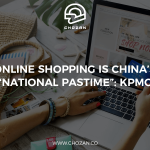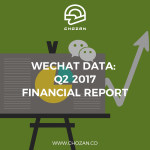On February 20th, CBNData and Taobao iFashion jointly released the “2017 iFashion Consumption Trend Report”.
Based on data from Alibaba and focusing on Taobao’s iFashion platform, the report revealed in-depth insights into consumer behaviour and predicted 8 iFashion consumption trends in China.
The “2017 iFashion Consumption Trend Report”
The influence of the younger generation in the fashion industry was the most prominent trend they noticed. The consumption of post-90s consumers has risen sharply and is expected to rise even more this year.
They also confirmed that brands cooperating with celebrities and Chinese KOLs is now an established industry model for online sales and marketing.
From statistics provided by CBNData, consumers from 18-25 years of age have the strongest growth rate. Two turning-points — entering university and going to work — account for this as these are the key stages when young people form their personal fashion understanding and get exposed to fashion more often.
The online fashion market is dominated by females with a woman/man ratio of 2:1. Post 80s and 90s consumers are the two most prominent generations of online fashion shoppers. The ratio of online shopping in 1st and 2nd tier cities is higher, while the number of online consumers in 3rd and 4th tier cities is larger.
In terms of growth, men have a higher growth rate than women, while post 90s and 95s have the most prominent growth.
Self-expression and novelty are the two strongest determinants for their decision making. For young consumers, “trendiness” is the key factor so brands have introduced trendy elements into their lines to make them stand out from common brands. Essential fashion consumption has gradually evolved into the non-essential realm.
The other big trend is that young consumers prefer to follow influencers. Pure product presentation no longer provides a compelling stimulus for consumers to buy. Meanwhile, popular celebrities, KOLs, UGC from peers and PGC from designers has become a strong driver for consumers to purchase. Consumers tend to trust their identity presentation and sense of taste. They tend to imitate them and buy similar products. Frequent celebrity exposure and watching highly rated TV shows had a huge impact on trend-setting and signalled young consumers’ fashion consumption choices.
Products named “Same-style with XX” have distinct sales advantages over regular ones, and this trend is growing. Yang Mi’s white shoes, Gao Yuanyuan’s army green coat, and Fan Bingbing’s dress are the most popular fashion pieces of 2016.
Apart from celebrities, more and more KOLs (Key Opinion Leaders) are influencing the fashion industry. According to CBNData’s report, KOLs can convert lower budgets into higher traffic generation with a strong fan effect, increasing their sales conversion rate.
Moreover, vertical industry KOLs are increasing. Consumers tend to favour KOLs with a specialisation. For example, wild-eyed Loli has established her sporty KOL image on Weibo, which help her increase her revenue on Taobao over 90% for sportswear.
In addition, the CBNData Report also pointed out that:
- male fashion brands will grow in 2017
- customised products will attract more attention
- content marketing will become more important for online fashion shoppers seeking in-depth and vertical product lines
- greater collaboration between technology brands and fashion brands is expected to increase
- and consumer-oriented business models, customisation and crowd-funding are going to expand.
To get deeper insights into Chinese social media marketing and utilizing it to serve your business, join ChoZan, a training and resources platform for Chinese social media marketers.
Please follow our official WeChat account to get more updates about the latest news, feature updates and case studies.

Share this article on your favourite social media









